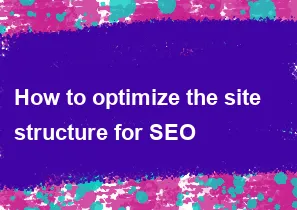How to optimize the site structure for SEO

Optimizing your site structure is crucial for SEO (Search Engine Optimization) as it helps search engines understand the content and hierarchy of your website. Here are some tips to optimize your site structure for better SEO:
Clear Hierarchy:
- Organize your content in a logical and hierarchical manner. Use categories and subcategories to create a clear structure. This helps both users and search engines navigate your site easily.
Intuitive Navigation:
- Design user-friendly navigation menus that make it easy for visitors to find information. Use descriptive labels and avoid overly complex dropdown menus.
SEO-Friendly URLs:
- Create clean and SEO-friendly URLs. Include relevant keywords and avoid using unnecessary parameters. A clear URL structure makes it easier for search engines to understand the content of a page.
Internal Linking:
- Use internal links to connect related pages. This not only helps users navigate your site but also distributes link equity throughout your content, boosting the SEO value of your pages.
Mobile-Friendly Design:
- Ensure your site is mobile-friendly. Google considers mobile compatibility as a ranking factor, so responsive design is crucial for SEO.
Page Load Speed:
- Optimize your site for fast page load speed. Use compressed images, enable browser caching, and leverage content delivery networks (CDNs) to improve user experience and SEO.
XML Sitemap:
- Create and submit an XML sitemap to search engines. This helps search engines index your pages more efficiently, ensuring that all relevant pages are crawled and included in search results.
Breadcrumb Navigation:
- Implement breadcrumb navigation to show users and search engines the path from the homepage to the current page. Breadcrumbs improve navigation and provide additional context to search engines.
Schema Markup:
- Use schema markup to provide additional information about your content to search engines. This can enhance the display of your search results and improve click-through rates.
404 Error Handling:
- Customize your 404 error page to guide users back to relevant content on your site. This helps maintain a positive user experience and prevents users from leaving your site due to dead ends.
Content Silos:
- Group related content into thematic silos or clusters. This helps search engines understand the topical relevance of your content and can enhance your site's authority on specific subjects.
Optimize Images:
- Use descriptive filenames and alt text for images. This not only improves accessibility but also provides additional context for search engines.
Remember that SEO is an ongoing process, and it's essential to regularly monitor your site's performance, make adjustments based on analytics data, and stay updated on SEO best practices and algorithm changes.
-
Popular Post
- How to optimize for Google's About This Result feature for local businesses
- How to implement multi-language support in an Express.js application
- How to handle and optimize for changes in mobile search behavior
- How to handle CORS in a Node.js application
- How to use Vue.js with a UI framework (e.g., Vuetify, Element UI)
- How to configure Laravel Telescope for monitoring and profiling API requests
- How to create a command-line tool using the Commander.js library in Node.js
- How to implement code splitting in a React.js application
- How to use the AWS SDK for Node.js to interact with various AWS services
- How to use the Node.js Stream API for efficient data processing
- How to implement a cookie parser middleware in Node.js
- How to implement WebSockets for real-time communication in React
-
Latest Post
- How to implement a dynamic form with dynamic field styling based on user input in Next.js
- How to create a custom hook for handling user interactions with the browser's device motion in Next.js
- How to create a custom hook for handling user interactions with the browser's battery status in Next.js
- How to implement a dynamic form with dynamic field visibility based on user input in Next.js
- How to implement a dynamic form with real-time collaboration features in Next.js
- How to create a custom hook for handling user interactions with the browser's media devices in Next.js
- How to use the useSWRInfinite hook for paginating data with a custom loading indicator in Next.js
- How to create a custom hook for handling user interactions with the browser's network status in Next.js
- How to create a custom hook for handling user interactions with the browser's location in Next.js
- How to implement a dynamic form with multi-language support in Next.js
- How to create a custom hook for handling user interactions with the browser's ambient light sensor in Next.js
- How to use the useHover hook for creating interactive image zoom effects in Next.js